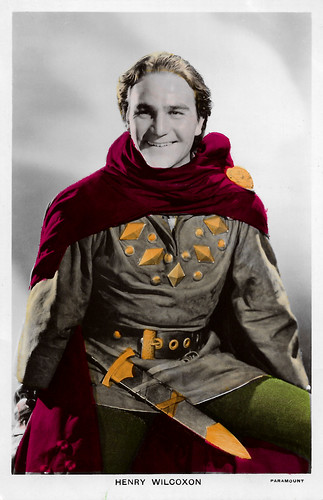
British postcard in the Colourgraph Series, London, no. C 248. Photo: Paramount. Henry Wilcoxon in The Crusades (Cecil B. DeMille, 1935).

Spanish collectors card, Series 2, no. 1 of 21. Photo: Paramount Pictures. Henry Wilcoxon as Richard Lionheart and Loretta Young as Berengeria in The Crusades (Cecil B. DeMille, 1935). Caption: The wedding of Richard and Berengaria.

Spanish collectors card, Series 2, no. 2 of 21. Photo: Paramount Pictures. Henry Wilcoxon in The Crusades (Cecil B. DeMille, 1935). Caption: The encounter.

Spanish collectors card, Series 2, no. 3 of 21. Photo: Paramount Pictures. Henry Wilcoxon and Loretta Young in The Crusades (Cecil B. DeMille, 1935). Caption: Underneath the balcony of Berengaria.
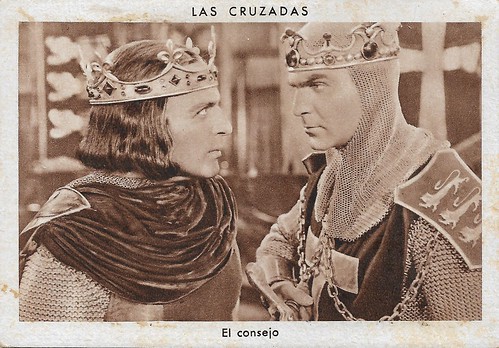
Spanish collectors card, Series 2, no. 4 of 21. Photo: Paramount Pictures. C. Henry Gordon as King Philip of France and Henry Wilcoxon as Richard Lionheart in The Crusades (Cecil B. DeMille, 1935). Caption: The council.
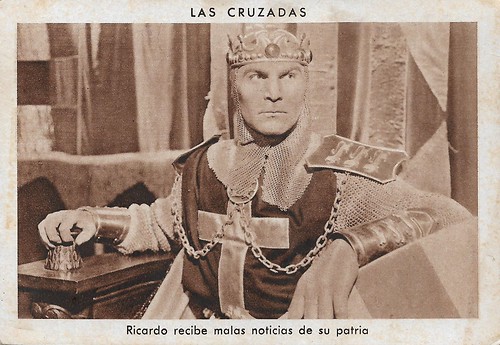
Spanish collectors card, Series 2, no. 5 of 21. Photo: Paramount Pictures. Henry Wilcoxon as Richard Lionheart in The Crusades (Cecil B. DeMille, 1935). Caption: Richard receives bad news from his homeland.
A man of action but little thought
The screenplay for The Crusades (Cecil B. DeMille, 1935) was written by Harold Lamb, Waldemar Young and Dudley Nichols. They took many of the film's elements and main characters from the Third Crusade (1190-1192), which was prompted by the Saracen capture of Jerusalem and the crusader states in the Holy Land in 1187. The character of Richard the Lionheart, King of England (Henry Wilcoxon), is a man of action but little thought.
A hermit from Jerusalem (C. Aubrey Smith) arrives in Europe and starts gathering support for a Crusade. The hermit convinces a number of European rulers to travel to Jerusalem in order to bring the Holy City into Christian hands. Richard enlists in order to avoid an arranged betrothal to the King of France's sister, Princess Alice of France (Katherine DeMille), but is followed by the Countess on the Crusade.
A plot is laid against Richard's life by his brother Prince John (Ramsay Hill) and Conrad, Marquis of Montferrat (Joseph Schildkraut). En route to the war, Richard meets Berengaria, Princess of Navarre (Loretta Young). In order to get food for his men, Richard reluctantly marries her in exchange for her father's cattle and grain. Berengaria is forced to accompany Richard to the Holy Land.
During the Crusaders' attempts to get past the walls of Acre, the allies assemble in a conference, but in disarray. Richard receives word that his brother John has seized the throne of England. Richard's ally, Philip II of France, is enraged at Richard's rejection of his sister Alice, but Richard defies Philip and the other troubled allies by proclaiming Berengaria Queen of England.
The Christian leaders meet in parley with the Muslim Sultan and leader Saladin (Ian Keith). Saladin is struck by Berengaria's beauty and bravery in supporting her husband. However, he rejects any truce with the Crusaders, and declares that the arrogant Richard will "never pass the gates of Jerusalem."

Spanish collectors card, Series 2, no 6. of 21. Photo: Paramount Pictures. Katherine DeMille as Princess Alice of France, Henry Wilcoxon and Loretta Young in The Crusades (Cecil B. DeMille, Paramount Pictures 1935). Caption: The dilemma.

Spanish collectors card, Series 2, no 7. of 21. Photo: Paramount Pictures. Henry Wilcoxon and Loretta Young in The Crusades (Cecil B. DeMille, Paramount Pictures 1935). Caption: Wedding night.

Spanish collectors card, Series 2, no. 8 of 21. Photo: Paramount Pictures. Scene from The Crusades (Cecil B. DeMille, 1935). The taking of St. Jean d'Acre.

Spanish collectors card, Series 2, no. 9 of 21. Photo: Paramount Pictures. Loretta Young in The Crusades (Cecil B. DeMille, 1935). Caption: The getaway of Berengaria.
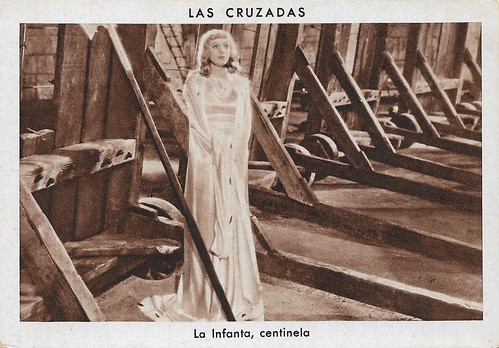
Spanish collectors card, Series 2, no. 10 of 21. Photo: Paramount Pictures. Loretta Young in The Crusades (Cecil B. DeMille, 1935). Caption: The Infanta as sentry.
Spreading a political or cultural agenda
Berengaria is fearful that her presence in camp is causing disloyalty among Richard's allies, in particular the powerful French King Philip (C. Henry Gordon), and may harm their holy quest. Seeking death, she enters no man's land between the lines, only to be wounded and captured by the forces of Saladin. The hermit, the Christian "holy man" who had preached the Crusade, also is captured. Saladin escapes the siege, and after finding Berengaria wounded, brings her to Jerusalem to care for her, with admiration and growing affection. Not knowing this Richard and the Crusaders storm Acre to save the Queen of England.
The internal plot against Richard's life is hatched by Conrad and disloyal soldiers. Conrad reveals his plot to Saladin, expecting to be rewarded. Appalled by Conrad's treachery, Saladin orders Conrad to be immediately executed. Berengaria offers herself to Saladin if he will intervene and save Richard's life. Saladin sends a few of his soldiers to warn Richard who is searching the battlefield at night for the body of a friend. Conrad's men attack Richard but are defeated by Saladin's soldiers who take the English King to Saladin.
Richard and Saladin agree to a truce and the gates of Jerusalem are opened to all Christians with the exception of Richard, in keeping with Saladin's earlier promise. After losing his kingship, his wife and the opportunity to see the Holy City, Richard prays for the first time, asking God for him to be reunited with his wife. Richard encounters Berengaria on her way to the Holy City. He admits his mistakes and Berengaria tells him that Saladin has freed her along with the other Christian captives. Berengaria proceeds alone toward Jerusalem to visit the Holy City and promises to return to him.
Lorraine K. Stock writes in 'Hollywood in the Holy Land', in her chapter 'Now Starring in the Third Crusade' that Crusading films have been used by European and American countries to spread a political or cultural agenda. One way in which this is done is through the main Crusading "heroes" such as Richard the Lionheart and the main antagonist Saladin. Many films have used the relationship between Richard I and Saladin.
In The Crusades the relationship between Richard I and Saladin is connected not only by the conflict of the Crusade but "an improbable, if entertaining, erotic triangle" with Berengaria of Navarre. Stock notes that this relationship and the events which occur can be seen as a reaction to events after the First World War and especially America's isolationism. For example, Richard the Lionheart at first does not want to get married, so he goes on the Crusade despite showing signs of not being religious. Berengaria can also be seen as a "medieval League of Nations" when negotiations between Saladin and Richard I occur at the end of the film.

Spanish collectors card, Series 2, no. 11 of 21. Photo: Paramount Pictures. C. Aubrey Smith as the Hermit and Loretta Young as Berengaria in The Crusades (Cecil B. DeMille, 1935). Caption: The Hermit and Berengaria cautious.
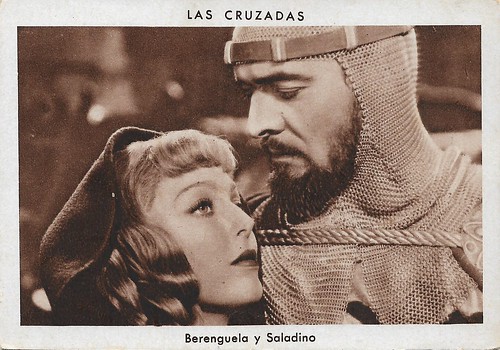
Spanish collectors card, Series 2, no. 12 of 21. Photo: Paramount Pictures. Loretta Young as Berengaria and Ian Keith as Saladin in The Crusades (Cecil B. DeMille, 1935). Caption: Berengaria and Saladin .

Spanish collectors card, Series 2, no. 13 of 21. Photo: Paramount Pictures. Joseph Schildkraut as Conrad, marquis of Montferrat and Loretta Young in The Crusades (Cecil B. DeMille, 1935). Caption: The traitor Montferrat.

Spanish collectors card, Series 2, no. 14 of 21. Photo: Paramount Pictures. Ian Keith (right) as Saladin in The Crusades (Cecil B. DeMille, 1935). Caption: The notice.

Spanish collectors card, Series 2, no. 15 of 21. Photo: Paramount Pictures. Henry Wilcoxon in The Crusades (Cecil B. DeMille, 1935). Caption: Richard saved.
The good and noble side of the Muslims
The main concern for such films as The Crusades is the way Muslims and Crusaders are portrayed. Throughout the film, Lorraine K. Stock notes that there are negative portrayals of Saladin and the Muslims. For instance Stock notes that the Crusaders are all dressed in mail armour with the cross upon their chests, while Saladin and the Saracens are dressed mainly in "flowing robes of luxury fabrics" and "silken sashes".
The Saracens are shown as oriental but also "exotically feminized" according to Stock. Another scene has the Saracens shoot a Crusader messenger, who demands the surrender of the city, with one of them wearing a helmet with devil horns upon it. There are other moments in which the Europeans mention devilry or call Muslims infidels. Stock says director Cecil B. DeMille established "the stereotypes of Richard and Saladin that subsequent films would repeat…".
However, Saladin is also depicted as an honourable man. In 'Islam, Muslims and Arabs in the Popular Hollywood Cinema', Anton K. Kozlovic writes "The Crusades was not as enthusiastically received in the West as DeMille would have liked, probably because it showed the good and noble side of the Muslims and contrasted it with the darker deeds of Christianity".
Saladin in the film refuses to help assassinate Richard I and in fact sends out help to prevent Richard from being killed by the treacherous other Europeans. Anton K. Kozlovic also notes that when Saladin offers peace to the "foes of Islam", Richard responds by drawing his sword "and saying 'We are going to slaughter you!'". Anton K. Kozlovic sees Cecil B. DeMille's The Crusades (1935) as a challenge to the stereotypical norm and negative picture painted of Muslims in Crusader films specifically.
Hal Erickson finally in his review at AllMovie: "In the film's most memorable scene, the fundamental difference between the boorish Richard and the cultured Saladin is demonstrated when the Saracen ruler delicately cleaves Berengaria's silk scarf in twain with his gleaming sword. It took a great deal of nerve to depict the film's hero as a thuggish brute and the nominal villain as the most sympathetic character in the story, but DeMille gets away with it in The Crusades, and still has time left over to deliver his usual quota of thrills, pageantry, convoluted history and campy dialogue. And yes, that is Ann Sheridan as a Christian captive in the opening scenes."
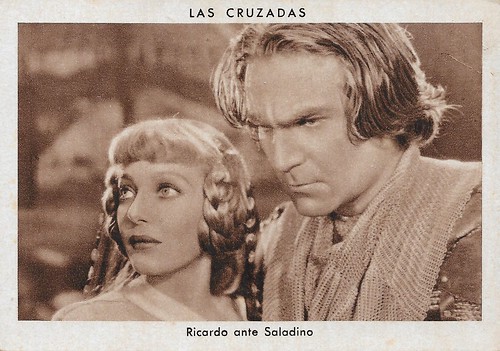
Spanish collectors card, Series 2, no. 16 of 21. Photo: Paramount Pictures. Henry Wilcoxon and Loretta Young in The Crusades (Cecil B. DeMille, 1935). Caption: Richard before Saladin.
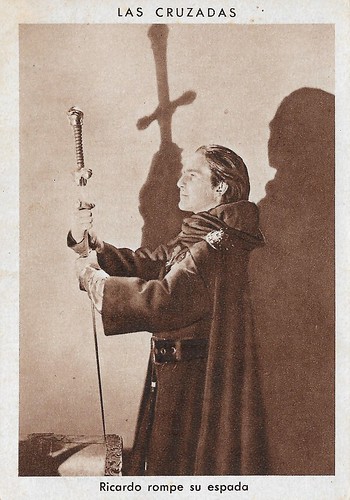
Spanish collectors card, Series 2, no. 17 of 21. Photo: Paramount Pictures. Henry Wilcoxon in The Crusades (Cecil B. DeMille, 1935). Caption: Richard breaks his sword.

Spanish collectors card, Series 2, no. 18 of 21. Photo: Paramount Pictures. Scene from The Crusades (Cecil B. DeMille, 1935). Caption: The March to Jerusalem.

Spanish collectors card, Series 2, no. 19 of 21. Photo: Paramount Pictures. Scene from The Crusades (Cecil B. DeMille, 1935). Caption: Before the Walls of Jerusalem.

Spanish collectors card, Series 2, no. 20 of 21. Photo: Paramount Pictures. Henry Wilcoxon in The Crusades (Cecil B. DeMille, 1935). Caption: The Sorrow of Richard.

Spanish collectors card, Series 2, no. 21 of 21. Photo: Paramount Pictures. Henry Wilcoxon and Loretta Young in The Crusades (Cecil B. DeMille, 1935). Caption: The Triumph of Faith and Love.
Source: Hal Erickson (AllMovie), Wikipedia and IMDb.
No comments:
Post a Comment